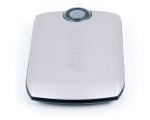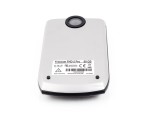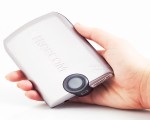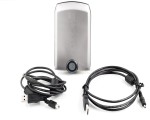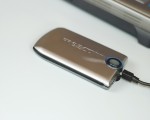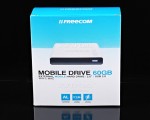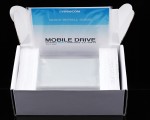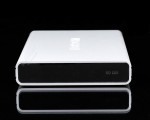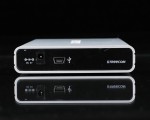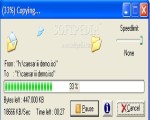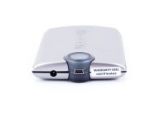I'll start this article by saying that I've got nothing personal against Freecom. I really liked their products when I first saw them, as almost all the mobile HDDs coming from this company have a very sleek and appealing look. However, when 2 such devices from the 3 I've had the chance of testing ?happened? to fail, I couldn't help but start wondering whether something was amiss here. I mean, when you say mobile storage solution, you think of something that should resist even some pretty nasty shocks, let alone being moved around and connected to several computers.
But it seems that either I've come across some defective products, or these things are not as tough as the manufacturers consider (and promote) them to be, because their behavior was not at all what I had expected.
First thing's first, let me introduce you to the aforementioned ?armada?. What we're dealing with here, in the order of failure, are the FHD-XS 1.8? 60 GB model, the FHD-2 Pro 2.5? 60 GB model and the Mobile Drive 2.5? 60 GB model. They were meant to be used for various file back-up operations around the office, and they've managed to carry out that job pretty well, for a while, that is. Actually, for as long as they weren't moved from their initial position. After being taken for a ride around several computers, the first two models went ?blonk-blonk?, meaning that they've crashed. I promise to offer a more detailed and ?scientific? explanation of the words ?blonk-blonk?, but that will happen a bit later on in this tri-review. For now, let's watch.....
Saved by the Looks: The Freecom HDD Armada Design Features
As mentioned in the beginning of this article, I've really loved the design of each of these devices. They have a very elegant and sleek look, although the Mobile Drive 2.5? is by far the most elegant of the three. The other two are more sporty-looking, their design inspiring mobility and data transfer on the go. On the other hand, these two are exactly the ones that crashed, making the famous saying ?Looks can be deceiving? perfect for this case. But enough with the generalities, let's see what's up (or down) with each of these devices.
FHD-XS 1.8? 60 GB
Unfortunately, I can't provide an ?in-house? photo for this one, as it was sent back to the vendor's service department before I was able to snap any pictures. That's why you'll have to rely on my description and a photo provided by the manufacturer in this case. The most interesting thing about this model is its built-in High-Speed USB extensible cable, which could prove to be quite useful, as it allows the user to simply plug-out/plug-in the mobile HDD without worrying about taking along any types of cables. Moreover, the big blue-shining button used for synchronization is kinda cool too, especially when it lights up during operation.
The FHD-XS is quite appealing from an aesthetic point of view as well, since it sports a metallic-gray color, which seems to be quite a good choice for these devices. It is small, lightweight, portable and, at a first glance, seems to be a great portable storage solution. That's what I thought too, until it crashed on me while testing it, of course.
FHD-2 Pro 2.5? 60 GB
This model is a bit bigger than the previous one, although it looks a lot like it. Actually, they could be considered to be some sort of ?cousins?, since they share quite a lot of features. Thus, the FHD-2 Pro also has that big blue button for file synchronization (I'll tell you all about this feature later on) and features the same color choices as its ?smaller brother?. However, the overall look of this model is more elegant and stylish, probably because the FHD-2 Pro is a bit bigger and its features are a little bit more visible.
Mobile Drive 2.5? 60 GB
In my opinion, this is the best - looking of the three (OK, perhaps I'm a little biased here, since this is the only one I really managed to test). Maybe it's the white + black color combo, maybe it's the relatively regular shape, or perhaps that sexy ?60 GB? led that lights up whenever a file transfer occurs. In any case, I'd say that this model is closer to the image of ?external HDD? than to that of ?Mobile Hard Drive?. But that's just me. You'll be able to judge for yourselves from the photos.
OK, that's it with the design. Let's see now what these devices are supposed to be capable of, namely the....
Technical specifications of the three Freecom Mobile Hard Drives according to the manufacturers
Once again, I'll divide this section into 3 sub-areas, each one presenting the theoretical features of one of our test subjects.
- Integrated USB 2.0 cable; - USB-bus powered; - high quality, slimline, robust design; - generates very little noise (if any); - one-button data synchronization; - combines flash + HDD capabilities.
FHD-2 Pro 2.5? 60 GB
- ultra-compact, 2,5" mobile hard drive; - interface: USB 2.0/1.1; - one-button data synchronization; - USB-bus powered; - high quality aluminum enclosure.
Mobile Drive 2.5? 60 GB
- dimensions: 13.2 x 8.3 x 1.8 cm; - weight: 300 grams; - aluminum enclosure; - no cooling fan, ensures quiet operation; - USB 2.0 interface; - USB-bus powered; - hot swappable; - color: silver; - low power consumption.
Enough specs for you? Well, in that case, let's see how....
Softpedia crash tested 3 Freecom Mobile HDDs and 2 of them didn't make it
Guess you knew this already, but that's exactly what happened. Out of the blue, with no sudden warning, no previous warning, no nothing. They just went...well, went ?blonk-blonk?. And it's about time to explain what these words mean. I'd say that they're a more or less (although I'd say more) accurate translation of the sound made by the mobile HDDs while (and after) they crashed. What really surprised me was the similarity of the sound (both the FHD-XS 1.8? and the FHD-2 Pro 2.5? generated kind of the same noise), which led me to believe that the problem that had caused them to crash was actually the same. I really don't know the reason behind their failure, so I won't go into any technical details, but what I WILL do is tell you the story behind each of these tests.
Crash Test No.1: FHD-XS 1.8? 60 GB
This one was used for around 3 months. Never moved it from its spot. Worked just fine. However, after it was taken on a walk out into the cold (inside a laptop bag) and then brought back indoors, it suddenly began to ?blonk-blonk?. Hasn't been subjected to any types of shocks while outside of the Softpedia offices. The probable ?cause of death? in this case was the sudden change of temperature (of around 10 Celsius degrees).
I don't think that the behavior of the FHD-XS 1.8? can be considered a ?normal? one, since it's supposed to resist temperature differences, as well as the ?stressful? action of being moved around. After all, that's what ?Mobile? stands for, doesn't it?
Well, in any case, it was after this unfortunate event that I've decided to carry out a more organized ?testing session? for these devices. I initially hoped that there will be just 1 crash, but boy, was I wrong.
Crash Test No.2: FHD-2 Pro 2.5? 60 GB
I kind of already expected something bad to happen when I first got my hands on this device, and, sure enough, it did. So, after unpacking it, I've plugged it in my computer's USB port and installed the software that comes with it, namely the Freecom Personal Media Suite, which allows the device to synchronize automatically with the computer, thus making backup operations as easy as...pressing a button. The suite is actually pretty cool, since it allows the user to create encrypted files, thus securing all the information transferred onto the HDD.
After carrying out this operation and reading the enclosed PDF manual, I've decided to take the test's ?intensity? up a notch, so I unplugged it (the correct way, by using the ?Safely Remove Hardware? option in the taskbar), and went to one of my colleagues' computer in order to transfer a larger file, which I was going to use later on for testing the device's transfer speed. No problems there, Windows XP recognized the external USB drive immediately and I was able to copy the file quite rapidly.
However, the moment I tried to connect the FHD-2 Pro 2.5? to my computer, disaster struck. Well, it was no hurricane Katrina, but just the dear old ?blonk-blonk?. Much to my despair, this device had also become ?dead in the water?, and, despite my efforts, I couldn't make it work anymore. After about 15 minutes of CPR, I was forced to declare the patient ?dead? and move on to another one.
Crash Test No.3: Mobile Drive 2.5? 60 GB
Actually, this wasn't a ?crash test?, since this model passed the test with flying colors. For the sake of the experiment, I've followed pretty much the same steps as in the case of the previous test. The Mobile Drive behaved perfectly. No ?blonk-blonks?. And in this case, I've actually been able to carry out some normal tests.
Thus, I've noticed that the maximum transfer speed is attained when transferring a file from the mobile HDD to the computer (around 20 MB/s), while during the reverse operation, the maximum speed was of around 13.67 MB/s. But after facing so many problems with the devices from this family I've decided to carry out a more serious test, so I've installed a program called Disk Bechmark, which offered me a pretty interesting set of results. You can check them out for yourselves in the picture, but allow me to point out one result. The HDD got the lowest score at the stress test. And with that, I rest my case, and move to....
The Freecom Mobile HDD Triad Roundup
What's Cool: I'm quite sorry to say this, but almost nothing. Yes, the last device in the series did pretty good, but the 2 successive crashes I had to put up with were very, very annoying. Especially since these devices are called ?mobile?. As mentioned before, maybe I've had the misfortune of coming across some defective products. I don't know. However, since the one ?survivor? did quite well in the tests, as mentioned before, I'll give them separate marks. Thus, the first 2 models are 0% In, while the Mobile Drive is 75% In.
What's not so Cool: Well, they crashed. That pretty much sums up what's not so cool about these devices. And, almost forgot, other ?thumbs down? elements are the facts that the provided USB cable is way too short and, for some reason, the manufacturers will supply a mains power adapter only if the user requests it (e-mail/phone call/etc.), despite the fact that there is a power jack on each device. For all these reasons, the first 2 models get an 100% Out, while the third one just a 25% Out.
Conclusions
I am really disappointed by the Freecom mobile hard drives. I really expected them to work a lot better under stress. They really look great, and are quite good at what they do....as long as they don't crash. So I do believe that - as long as you don't move them around too much - you're OK, although you'll probably soon realize that you don't have a mobile hard drive on your hands, but an external one. In any case, in light of the events presented above, I've decided to entrust my personal and important data to a 4 GB flash drive and use the Freecom as an extra-HDD unit. It's safer.
[UPDATE] After 2 months from my initial review, the 3'rd Freecom Mobile HDD, the one that actually worked during the tests, finally crashed after being moved just once from its initial position. I'm sorry to say, but these things are not at all trustworthy (read they're pieces of technological junk), and you should really be extremely careful should you decide to purchase one of them. You might wind up losing your money for nothing, as we here at Softpedia did.
Still Images from the Freecom Mobile HDDs' review.
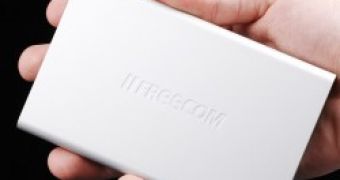
 14 DAY TRIAL //
14 DAY TRIAL // 
